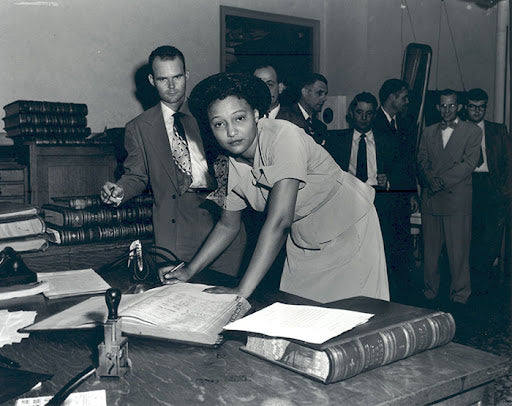Many paved the way!
Ada Lois Sipuel was born February 8, 1924 in Chickasha, Oklahoma, The Encyclopedia of Oklahoma History and Culture reports. In 1941, she graduated from Lincoln High School as valedictorian before enrolling at Arkansas A&M College at Pine Bluff. In September 1942, she transferred to Langston University with dreams to become a lawyer, marrying in March 1944 before graduating from Langston with honors.
Despite Sipuel’s massive educational achievements, the educational system in Oklahoma was still segregated. When it came time to prepare for law school, Sipuel had few options since Langston didn’t have one. While the state provided money for students to attend graduate and law schools that accepted Black students outside of Oklahoma, the NAACP ended up convincing 21-year-old Sipuel that she should try to seek acceptance to the University of Oklahoma’s law school in an effort to challenge segregation laws. She complied and on January 14, 1946, she applied to the University of Oklahoma College of Law.
University president Dr. George Lynn Cross explained to Sipuel that while academically there was no reason to deny her admissions request, legally, Oklahoma statutes prevented Blacks and whites from attending classes together. The school could be fined up to $50 daily while white students who attended classes with a Black student could be fined up to $20 daily, causing them to reject her application on the basis of race alone. With the support of organizers in the state, Sipuel filed a lawsuit in the Cleveland County District Court on April 6, 1946, prompting a three-year battle for educational equity.
Represented by then-lawyer Thurgood Marshall, who would soon become the first Black U.S. Justice, Sipuel lost her district court case, appealing to the Oklahoma Supreme Court. The higher court maintained the ruling of the lower court, and Sipuel eventually petitioned to the highest court in the land, the U.S. Supreme Court. On January 12, 1948, the courts ruled on Sipuel v. Board of Regents of the University of Oklahoma, declaring that the University must provide Sipuel “with the same opportunities for securing a legal education as it provided to other citizens of Oklahoma.”
While the Supreme Court’s ruling was clear, the case was remanded back to the Cleveland County District Court to enforce the ruling. In an effort to shirk their legal responsibilities, the Oklahoma Legislature decided that rather than admit her to the University of Oklahoma’s law program, they would create a separate law school, Langston University School of Law, for Sipuel to attend. The school was created in five days, and Sipuel was expected to attend classes alone in the State Capitol’s Senate rooms. Sipuel refused, and her lawyers filed a motion in the District Court on March 15, 1948 arguing that the Langston law school didn’t provide an equivalent legal education to Black students. However, the court ruled against her, and the Oklahoma Supreme Court upheld their findings. As a result, they petitioned again to appeal to the U.S. Supreme Court, but the state’s attorney, General Mac Q. Williamson, conceded, declining to return to D.C. on behalf of the state. On June 18, 1949, the University of Oklahoma College of Law was forced to admit Ms. Ada Lois Sipuel Fisher to their school, and Langston University law school closed just 12 days later.
While Sipuel Fisher still experienced racism on campus, being forcibly segregated in classes, during school sporting events, and in various facilities across campus, she continued her time at OU law school, graduating in 1952 and going on to earn her master’s from the University of Oklahoma in 1968. Her case paved the way for a number of other cases allowing Black students to attend previously segregated graduate schools, including the 1950 McLaurin v. Oklahoma State Regents case, granting the abolition of segregation at Oklahoma State University which sparked nationwide desegregation at graduate schools.
Sipuel Fisher would go on to serve as a faculty member and chair of the Department of Social Sciences at Langston University in 1957, retiring three decades later in 1987 as Assistant Vice President for Academic Affairs. In 1991, the University of Oklahoma paid homage to Sipuel Fisher’s contributions to civil rights, presenting her with an honorary doctorate of humane letters. On April 22, 1992, Gov. David Walters appointed Dr. Ada Lois Sipuel Fisher to the Board of Regents at the University of Oklahoma, the same University she was denied admittance to nearly 50 years prior. Dr. Sipuel Fisher passed away on October 18, 1995, and the University of Oklahoma dedicated the Ada Lois Sipuel Fisher Garden on the Norman Campus in her honor.
If it was not for the work of Fisher and so many other civil rights leaders who aided and supported her, Black students would’ve continued being denied the right to a quality and equitable graduate education as their white counterparts. In honor of the 75th anniversary of the U.S. Supreme Court’s historic decision in the Sipuel vs. Board of Regents case, we remember the life and legacy of Dr. Ada Lois Sipuel Fisher. Because of her, we can.
Here’s how the Sipuel vs. Board of Regents case affects you today. Ada Sipuel Fisher signing the register of attorneys, 1952. Photo Courtesy of Meyers/Barney Hillerman Photographic Collection/Oklahoma Historical Society

